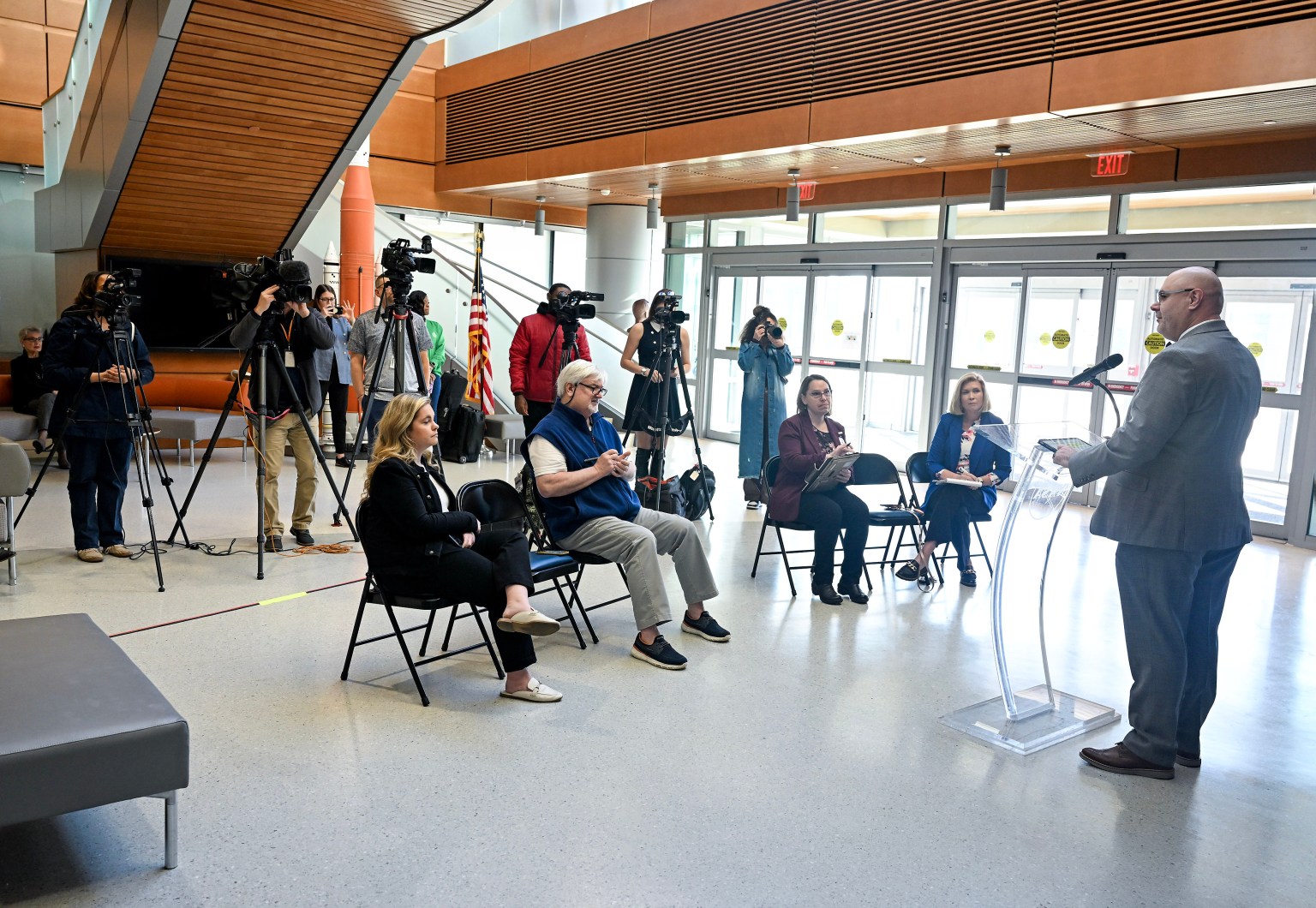
Marshall Center Director Holds First Media Event
By Jessica Barnett
NASA Marshall Space Flight Center's newest center director, Joseph Pelfrey, took to the podium Feb. 15 in the lobby of Building 4221 to host his first media event since his appointment to the position.
Pelfrey, who had been serving as acting center director since August 2023, is the 15th center director for Marshall. He succeeded Jody Singer, who retired in July 2023.
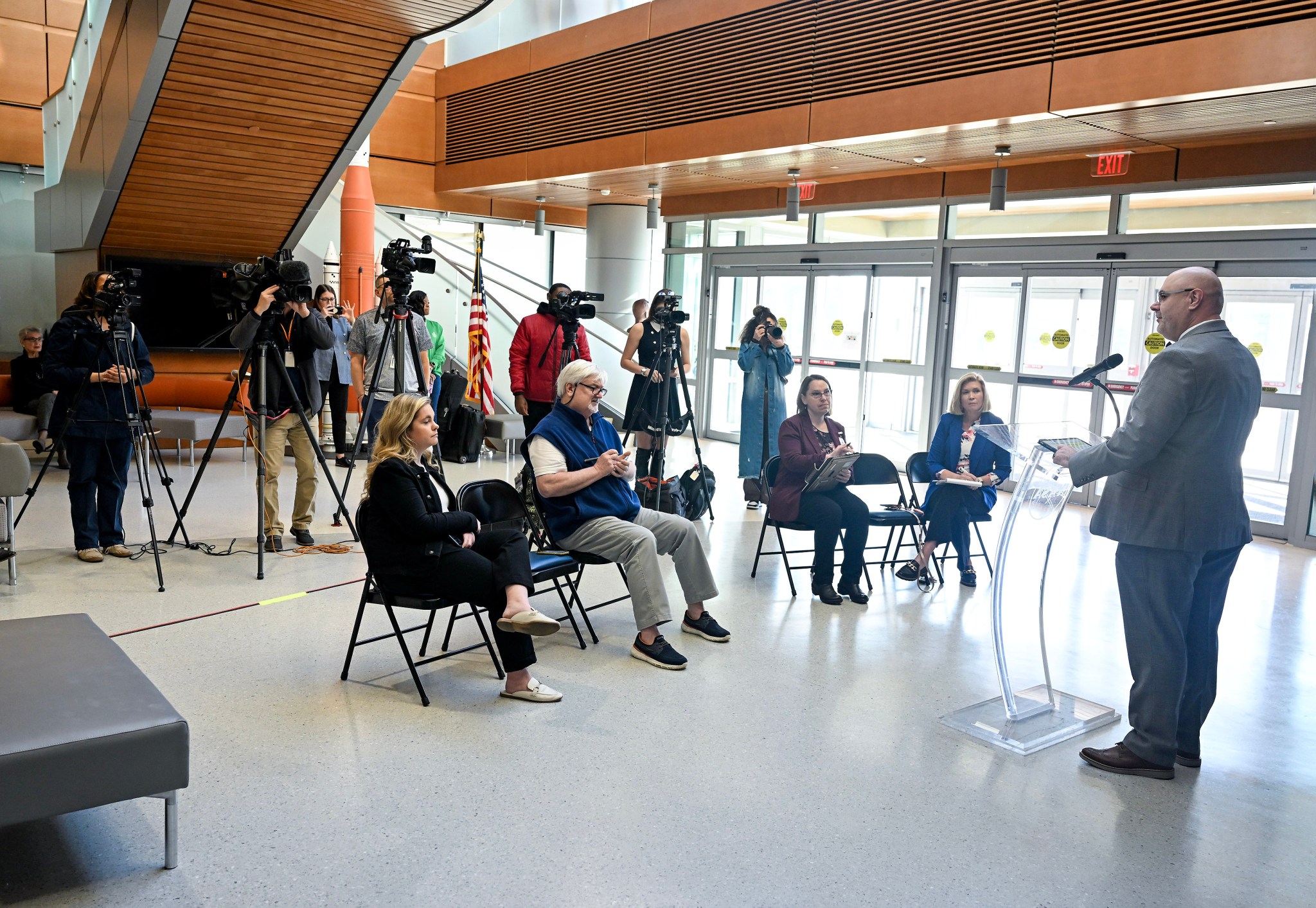
Appearing before local news cameras and reporters, Pelfrey said he was humbled and honored to receive the call from NASA Administrator Bill Nelson with news of his selection.
"The agency is committed to Marshall's role in supporting what we do as a nation in space exploration," Pelfrey said. "I am honored that they have confidence in me and our team to continue to lead."
Pelfrey took the opportunity to speak to reporters about upcoming milestones for the center, such as the celebration of 25 years of work with the Chandra X-ray Observatory, Marshall's 30th year hosting the Human Exploration Rover Challenge, two years since the launches of the James Webb Space Telescope and IXPE (Imaging X-ray Polarimetry Explorer) observatory, and the recent launch of the LN-1 (Lunar Node 1) navigation beacon.
He also discussed the center's plans to use more of its testing capabilities for habitation systems; build a new Engineering Science Laboratory to replace Building 4487; build the Marshall Exploration Facility where Building 4200 once stood; and continue supporting operations at the International Space Station and for future Artemis missions.
Looking to the future, Pelfrey said Marshall is focused on helping NASA expand its missions in deep space and developing the technologies needed to carry astronauts farther than "we've ever been before."
A child of the shuttle generation, Pelfrey recalled watching launches and dreaming of a career at NASA. He said he's honored to follow behind great center leaders, continuing Marshall's legacy as a leader in space exploration.
"As we write the next chapter of our story, I am confident of the bright future we have at Marshall Space Flight Center," he said.
Barnett, a Media Fusion employee, supports the Marshall Office of Communications.
Pelfrey Hosts First 2024 All-Hands at Marshall
By Celine Smith
New NASA Marshall Space Flight Center Director Joseph Pelfrey highlighted the center's strategy and changing culture during this year's first all-hands meeting Feb. 8 in Activities Building 4316.
The meeting - with the theme "More to Marshall" - was Pelfrey's first all-hands since NASA Administrator Bill Nelson named him as the center's 15th director Feb. 5. Pelfrey had served as acting director since Jody Singer's retirement in July 2023.
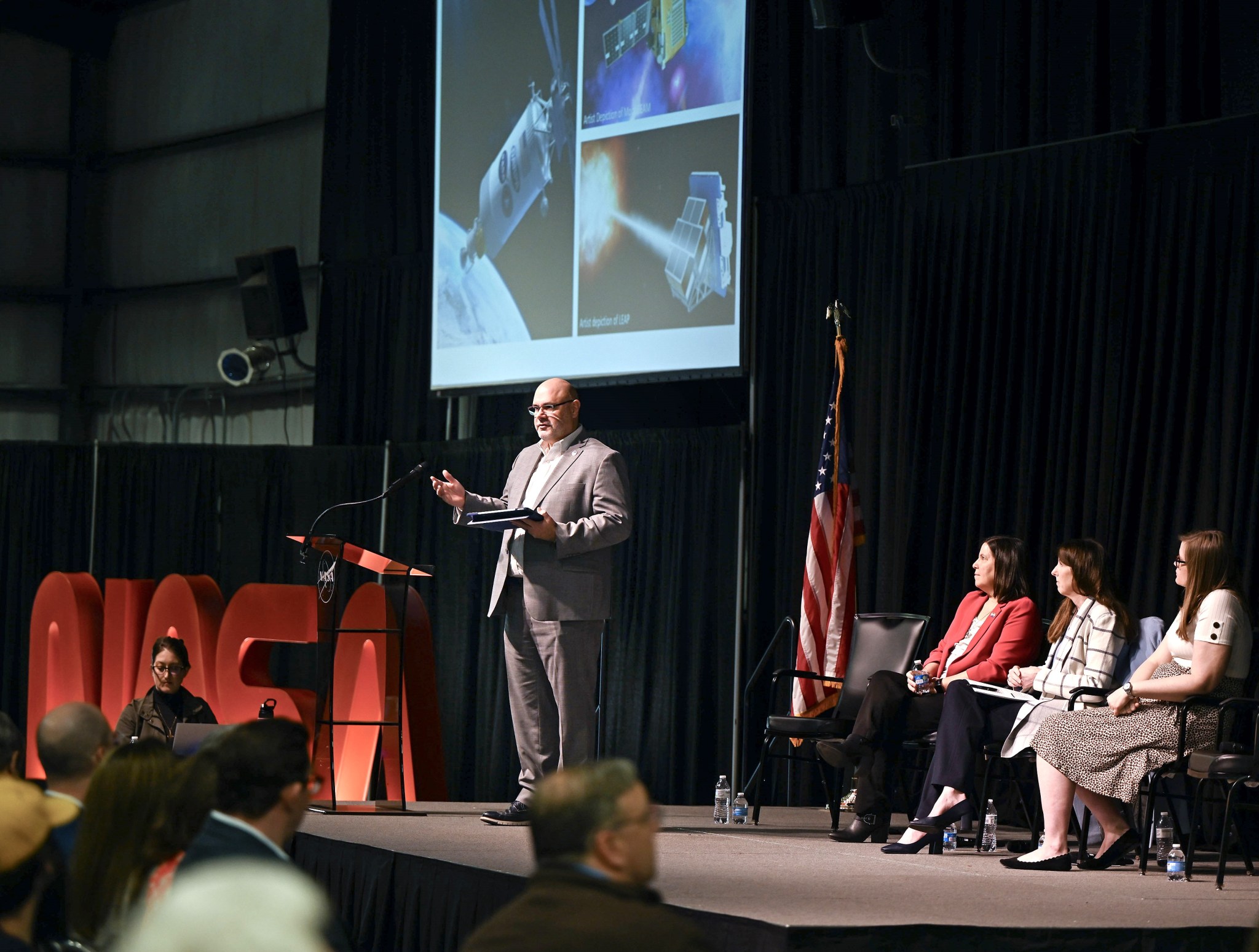
Along with Pelfrey, Tia Ferguson, director of Marshall's Space Systems Department in the Engineering Directorate, Rae Ann Meyer, associate center director, and Mallory James, an aerospace engineer and management assistant in the office of the center director, gave presentations about the direction of Marshall in 2024.
"I see us embracing a transformative shift to a portfolio of more small and medium-sized projects enabled through strategic partnerships while also being a technical solutions provider to NASA and our partners," Pelfrey said. "I see a very bright future for our center, and I'm excited to write this next chapter with all of you."
Pelfrey commended Marshall team members for submitting 63 proposals to NASA's Space Technology Mission Directorate, all enabled by partnerships. Marshall submitted and won the most proposals out of all NASA centers. He encouraged team members to continue creating and working on more innovative ideas to support future Agency needs.
Pelfrey gave updates on Marshall's various projects, including Lunar Node-1 using the Huntsville Operation Support Center for its mission and Marshall partnering with the Italian Space Agency to create a multipurpose habitat that could be used on the Moon. The habitat is in the process of becoming a part of the Artemis architecture and would be the first of its kind on the lunar surface.
Pelfrey shared that Marshall and industry partners will be leading the development of the engine in collaboration with the Department of the Defense for NASA and DARPA's DRACO (Demonstration Rocket for Agile Cislunar Operations), the first nuclear thermal flight demonstration intended for the mission to Mars. Pelfrey also highlighted the development of the solar sail prototype, which is approximately 4,700 square feet and was recently tested with NASA's industry partner. The potential for this design has drawn attention from future science missions and the Department of Defense due to its advancements in propulsion.
Pelfrey also mentioned that NASA's Michoud Assembly Facility, which is managed by Marshall, is manufacturing parts for Artemis III-V. Pertaining to the Artemis Mission, Pelfrey said the data from Artemis I is being examined to prepare for Artemis II. Flight software testing has been completed for Artemis II as well. The Human Landing System team is continuing to work with lander partner, SpaceX, which is preparing for the next Starship orbital flight test in the next few weeks.
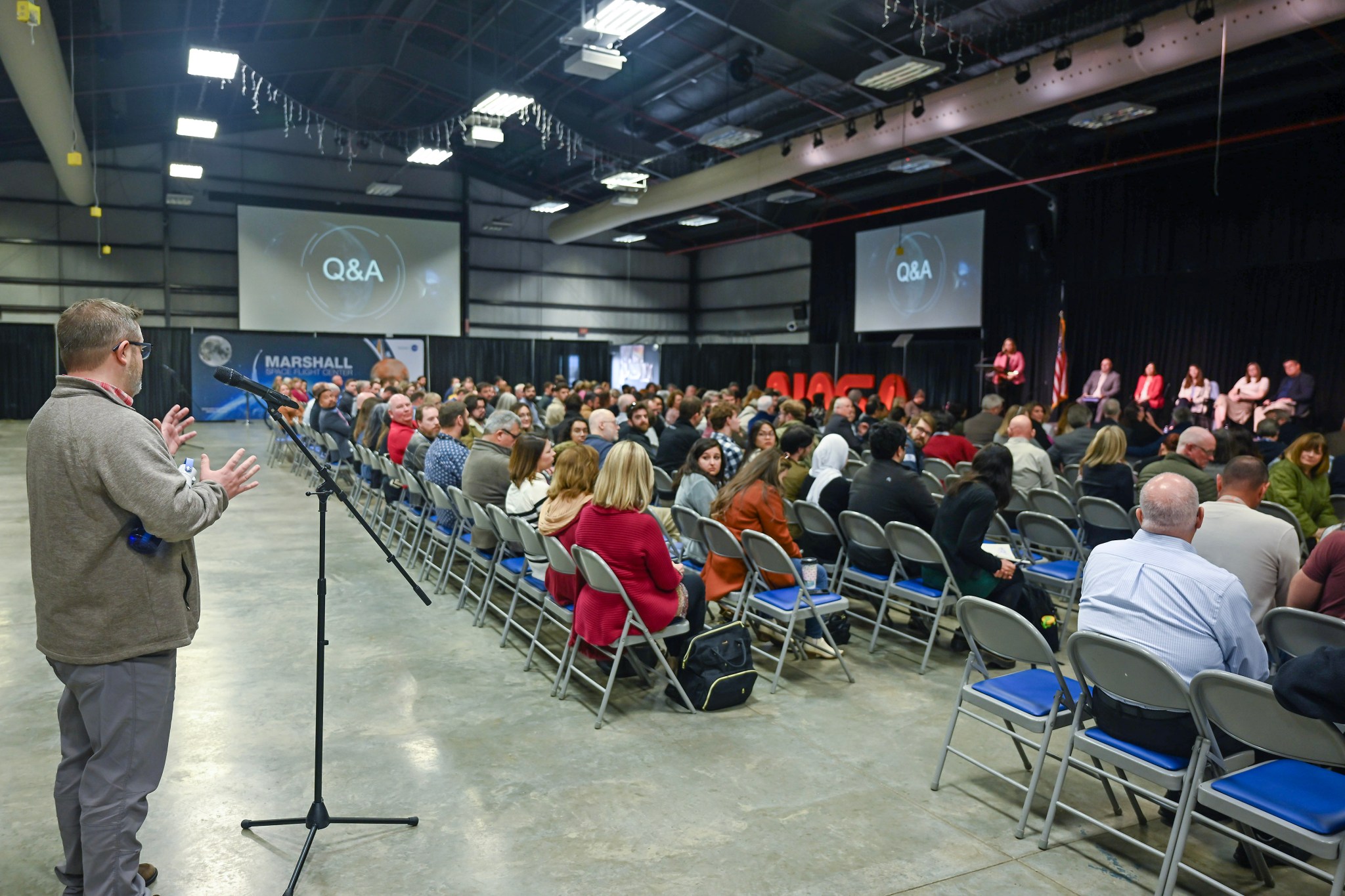
According to Pelfrey, Marshall is also expecting two new buildings, the Marshall Exploration Facility, which is tentatively scheduled to break ground in 2026, and an Engineering Science Lab, a replacement for Building 4487.
Ferguson followed Pelfrey's presentation with updates about NASA 2040, an agency strategic initiative propelling NASA into the future. The initiative aims to drive meaningful changes in the present to ensure that, in 2040, NASA remains the preeminent institution for research, technology, and engineering, to lead science, aeronautics, and space exploration for humanity. She went into detail about plans made to optimize the internaloperations of the agency and improving the work environment for team members to achieve mission goals.
Meyer discussed how Marshall's culture reflects the changes and new strategies taking place. Meyer emphasized the investment in centerwide events to strengthen culture at Marshall.
James, a mentee of Meyer, gave the last presentation. She discussed the results of the Federal Employee Viewpoint Survey and how leadership is moving forward to address concerns expressed from the results.
All-hands ended with a Q&A panel with Pelfrey, Ferguson, Meyer, and James. Larry Leopard, associate director, technical, also joined the panel. They answered questions submitted online and from the audience.
"With our long history of what we've done at the center, there's so much more to Marshall that we can achieve," Pelfrey said in his closing remarks. "There's so much more that we can dare to dream and explore and innovate for the agency and there's more to gain when we do it together."
Smith, a Media Fusion employee, supports the Marshall Office of Communications.
Black History Month Profile: Evolving with Leslie Smith
By Celine Smith
Ever since Leslie Smith was young, she has liked working with her hands, whether it be arts and crafts or playing the piano. Watching her father weld pieces of scrap metal into something new reinforced her enthusiasm for designing and creating.
While working for NASA's Marshall Space Flight Center, Smith has been able to pursue her passion of more tactile work while also gaining an array of other skills.

"Helping put the next man and first woman on the Moon gives me a sense of pride, especially because it could help us get to Mars," said Smith, who is the task manager of the Sustaining Lunar Development program. "I love knowing I'm helping the next generation and just being a part of the program."
As a young girl, Smith aspired to be an architect, which combined her two favorite skills of designing and building. While in high school, Smith began to co-op at a technical vocational school. Her interest in architecture increased when she was introduced to CAD (computerized-aided design) software in a drafting class.
After Smith started at Tuskegee University, a historically Black university in Alabama, her sights changed. "The architecture class seemed more artsy, and not as focused on design or manufacturing, which is what I really wanted to do," said Smith, who is from Vicksburg, Mississippi.
She decided to major in mechanical engineering instead. Before graduating, Smith signed an offer for a co-op opportunity with Marshall during a 2008 Tuskegee job fair, leading to her 15-year career at the center.
During Smith's start, she didn't get to immediately do the CAD work she originally was drawn to. Smith began working in the Planning and Operations branch within the Mission Ops Lab. She oversaw the countdown timeline for operational tasks and filled out functional objective sheets for the Constellation program's Ares I. Later, she performed 3D CAD modeling for the main propulsion system and 2D drawings and assemblies for the cryogenic propellant storage and transfer system.
The experience served as Smith's introduction to program management and systems engineering. While her role was not originally in her area of interest, she found a reason to stay.
"I stayed because of the people," Smith said. "They were very friendly and helpful. Also, after taking a tour of Marshall, I saw all capabilities of the center. Marshall's friction stir welding, 3D printing, the propulsion lab, and the diverse types of engineering intrigued me."
Her first full-time role at Marshall took place after graduating college. She began as a design engineer in the Propulsion Detailed Design branch in 2013. She used her CAD skills to draft a 1 Newton thruster, an adapter for secondary payloads, and a core stage auxiliary power unit among other projects. Smith also did some friction stir welding and additive manufacturing, the processes that interested her during her co-op days. Before becoming a key coordinator for human landing systems, she conducted trade studies for SLS (Space Launch System) components as a systems engineer in 2018. Now, Smith manages human landing system concepts, focused on reducing risk and the advancement of key technologies.
"I'm the kind of person who likes to do something different every so often," she said. "Technology is always evolving so that makes me want to always evolve."
Smith's passion for engineering is present in her personal life. As a member of the National Society of Black Engineers, she took part in the Arusha Project, started at NASA's Johnson Space Center. Arusha is Swahili for "he makes fly (into the skies)." Smith joined other Black engineers to build a rover for potential Moon and Mars missions. Smith personally worked on the outer shell, window, and chassis.
"The project was great because you got to work with other African American engineers and other ethnicities," she said. "It's important to be around people who look like you and can relate to similar issues."
In Smith's free time she volunteers to do STEM outreach. She also enjoys basketball, swimming, and reading. Smith currently lives in Madison, Alabama.
Her advice for young engineers at Marshall is to: "learn all you can. Talk to as many people as you can, particularly people who are different from you for a different perspective. Never pass an opportunity to see hardware. Take all the tours and attend mentoring events."
First in a two-part series in the Marshall Star highlighting team members during Black History Month.
Smith, a Media Fusion employee, supports the Marshall Office of Communications.
Deputy Director of NASA Safety Center Speaker for Feb. 22 Mission Success Forum
By Wayne Smith
Bob Conway, deputy director of the NASA Safety Center, will be the guest speaker for the Mission Success Is in Our Hands hybrid Shared Experiences Forum on Feb. 22 at NASA's Marshall Space Flight Center.
The 11:30 a.m. event will be in Activities Building 4316 for Marshall team members. Light refreshments will be served. The forum is available to NASA employees and the public virtually via Teams.
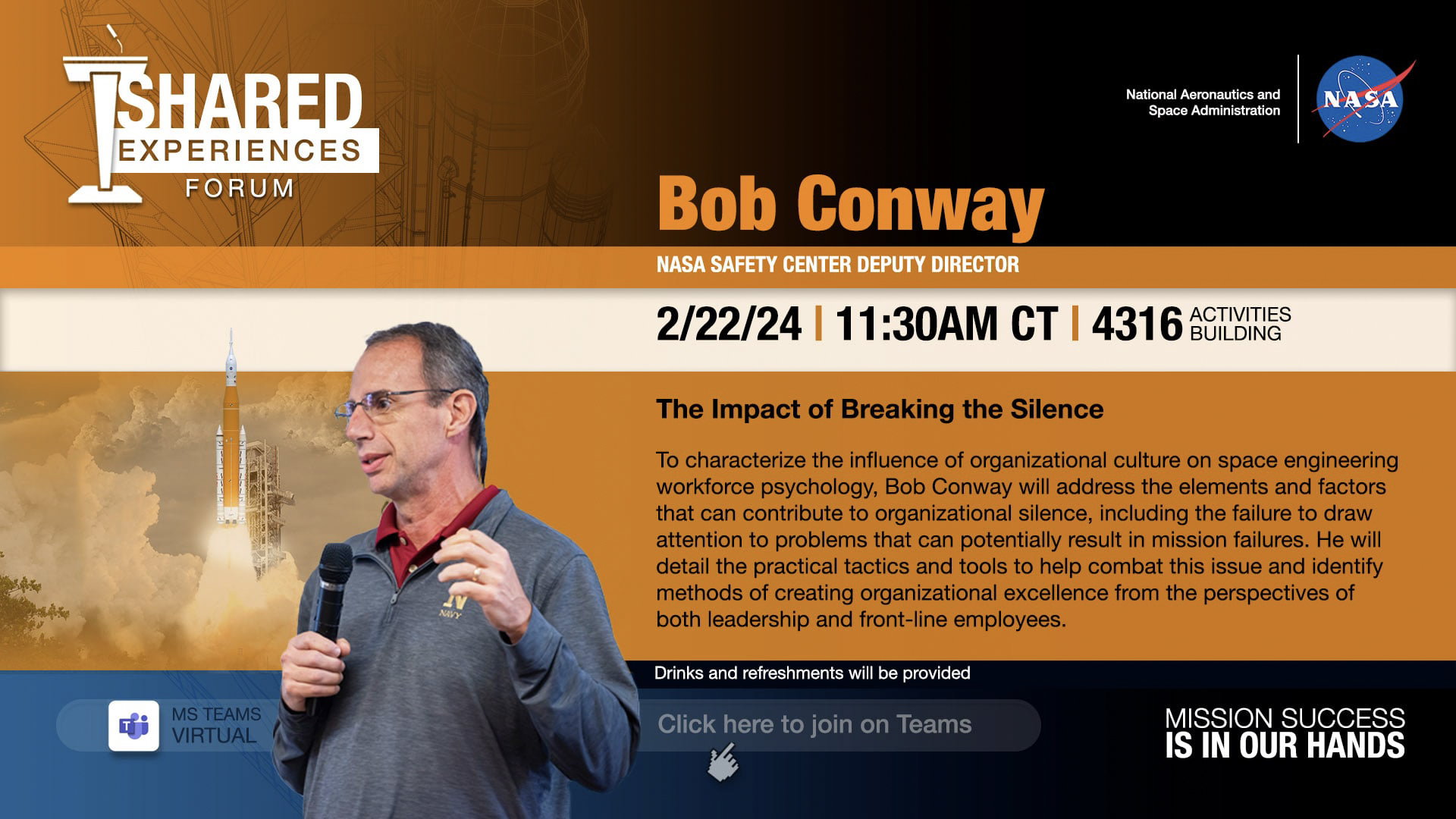
Mission Success Is in Our Hands is a safety initiative collaboration between NASA's Marshall Space Flight Center and Jacobs Engineering. The initiative's goal to help team members make meaningful connections between their jobs and the safety and success of NASA and Marshall missions.
The theme of the forum is "The Impact of Breaking the Silence." Conway will address the elements and factors that can contribute to organizational silence, including the failure to draw attention to problems that can potentially result in mission failures. He will detail practical tactics and tools to help combat this issue and identify methods of creating organizational excellence from the perspectives of both leadership and front-line employees.
Bill Hill, director of Safety and Mission Assurance at Marshall, encourages team members to attend the forum in-person.
"Administrator (Bill) Nelson has requested that all NASA civil servants and contractors hear Bob Conway's organizational silence briefing and learn tools and techniques to avoid the pitfalls of organizational silence," Hill said.
Jeff Haars, Jacobs vice president and program manager for Jacobs Space Exploration Group, said the Shared Experiences Forum is an impactful reminder on safety.
"At Jacobs, we put a high priority on safety so it's very reassuring to have a great safety partner like Marshall," Haars said. "Working as a team allows us to deliver our work safely while contributing to mission success."
Conway works with the NASA Safety Center's director to enable more effective and efficient safety and mission assurance support for NASA's portfolio of programs and projects by managing the safety center's activities in knowledge sharing and analysis, technical excellence, and assessments and investigations.
Prior to assuming this role, Conway worked in the civilian sector as the manager of Quality Engineering for Worldwide Safety and Health at the Walt Disney World Resort in Orlando, Florida, from 2012 to 2019. Conway was also a member of the NASA Aerospace Safety Advisory Panel from 2012 to 2016. In this role he evaluated various NASA programs and, with his Naval Aviation Safety background, was the lead panel representative to the NASA Aircraft Mission Directorate. After his commissioning as an ensign, Conway served in the U.S. Navy through his retirement in 2012.
As part of the forum, Mission Success Is in Our Hands will present the Golden Eagle Award to a Marshall team member. The award promotes awareness and appreciation for flight safety, as demonstrated through the connections between employees' everyday work, the success of NASA and Marshall's missions, and the safety of NASA astronauts. The award recognizes individuals who have made significant contributions to flight safety and mission assurance above and beyond their normal work requirements. Management or peers can nominate any team member for the award. Honorees are typically recognized at quarterly Shared Experiences forums.
Smith, a Media Fusion employee and the Marshall Star editor, supports the Marshall Office of Communications.
NASA Science Aboard Intuitive Machines Continues Journey to Moon, Landing Coverage set for Feb. 22
After a successful launch Feb. 15, six NASA science instruments and technology demonstrations continue their journey to the Moon aboard Intuitive Machines' lander named Odysseus. The company confirmed communications contact with its mission operations control in Houston, and its lander continues to perform as expected.
As part of NASA's CLPS (Commercial Lunar Payload Services) initiative and Artemis campaign, Intuitive Machines is targeting no earlier than 4:49 p.m. CST on Feb. 22 to land their Odysseus lunar lander near Malapert A in the South Pole region of the Moon.
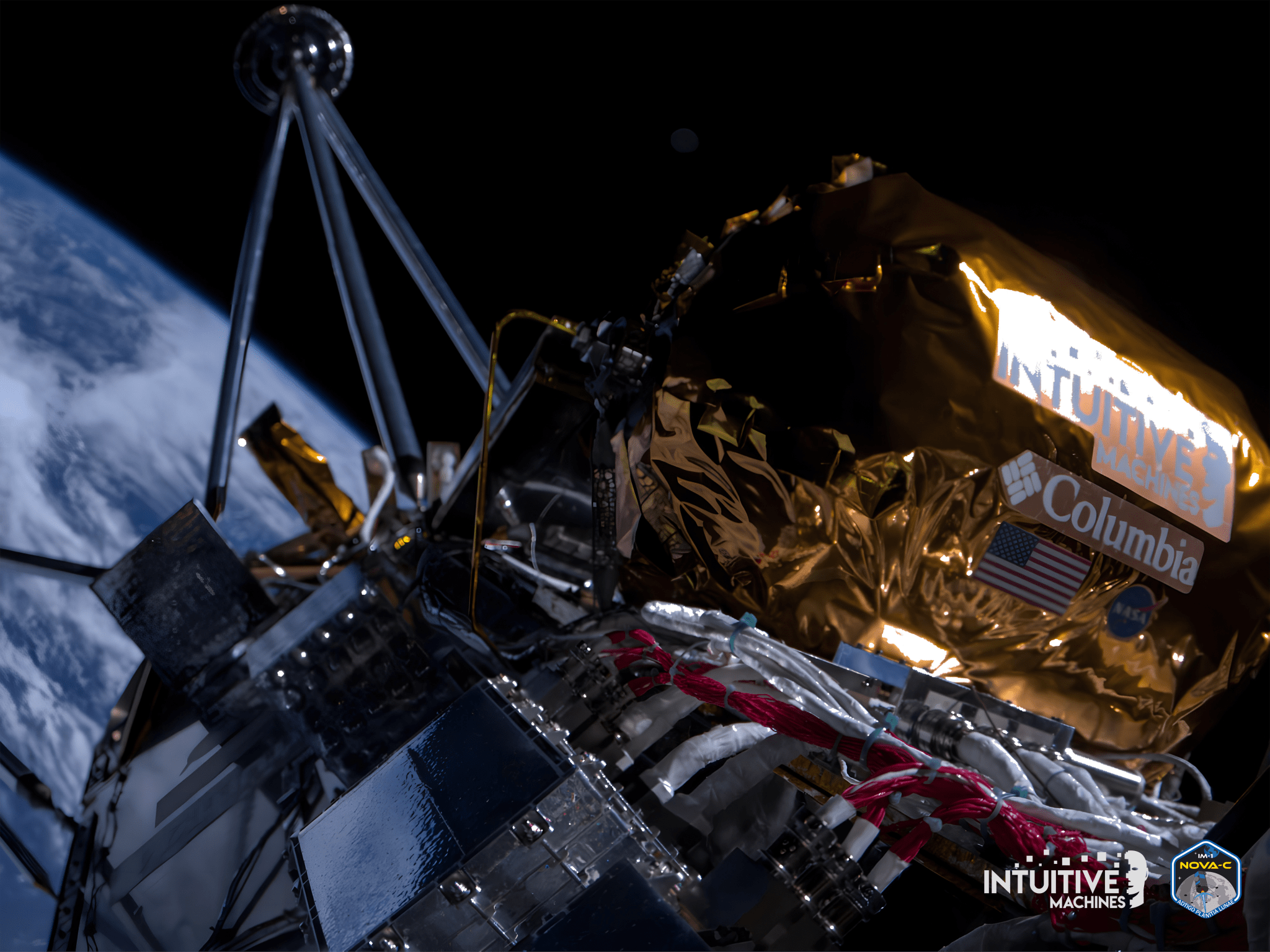
Live landing coverage will air on NASA+, NASA Television, the NASA app, and the agency's website. NASA TV can be streamed on a variety of platforms, including social media. Coverage will include live streaming and blog updates beginning 3:15 p.m., as the landing milestones occur. Upon successful landing, Intuitive Machines and NASA will host a news conference to discuss the mission and science opportunities that lie ahead as the company begins lunar surface operations.
Known as IM-1, Intuitive Machines successfully transmitted its first images back to Earth on Feb. 16. These were captured shortly after separation from SpaceX's second stage, on Intuitive Machines' first journey to the Moon.
Within an hour of launching, NASA confirmed data was streaming from the agency's powered science and technology instruments aboard the flight. This means data from these instruments was automatically streaming back to the teams so NASA could monitor the health and status of its instruments.
Later, Intuitive Machines successfully commissioned Odysseus' engine which means they exercised the engine's complete flight profile, including the throttling required for landing. The engine, which uses liquid methane and liquid oxygen, is the first of its kind fired in space.
One of the NASA instruments, the Radio Frequency Mass Gauge is gauging the cryogenic propellants on Odysseus throughout the mission. Data files have been collected and many have been downloaded for analysis. Throughout the propellant loading phase that took place before launch, the instrument collected data, which was downloaded and analyzed in near-real time. Data also is being collected during the microgravity transit phase of the mission. This analysis will continue through landing on the Moon.
Another NASA instrument, Lunar Node-1, or LN-1, integrates navigation and communication . LN-1 was developed, built, and tested at NASA's Marshall Space Flight Center. This science instrument will operate daily during the cruise phase as the landing date draws closer. The radio beacon is designed to support precise geolocation and navigation observations to orbiters, landers, and surface personnel, digitally confirming their positions on the Moon relative to other craft, ground stations, or rovers on the move. The check-out helps prepare to land on the Moon as the navigation demonstrator aims to gather this data throughout the duration of the surface operations phase of the mission. Flight controllers will analyze the data from this procedure to inform preparations for landing Feb. 22.






